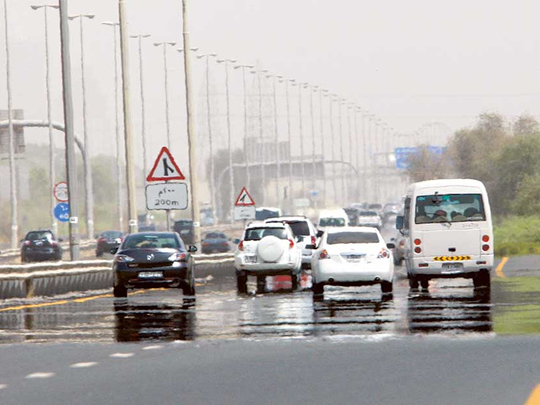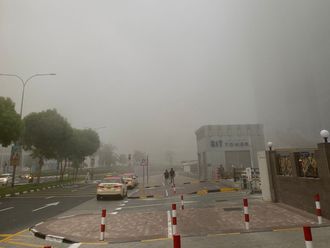
Dubai: The Arabian Gulf and parts of Iran will suffer heatwaves beyond the limit of human survival if climate change is unchecked, according to a new scientific study.
The extreme heatwaves will affect Abu Dhabi, Dubai, Doha and coastal cities in Iran and will pose a deadly threat to millions of pilgrims in Saudi Arabia when the Haj will fall in summer. The study shows the extreme heatwaves, more intense than anything ever experienced on Earth, would kick in after 2070 and that the hottest days of today would by then be a near-daily occurrence.
“Our results expose a specific regional hotspot where climate change, in the absence of significant [carbon cuts], is likely to severely impact human habitability in the future,” said Prof Jeremy Pal and Prof Elfatih Eltahir, both at the Massachusetts Institute of Technology, writing in the journal Nature Climate Change.
They said the future climate for many locations in the Gulf would be like today’s extreme climate in the desert of Northern Afar, on the African side of the Red Sea, where there are no permanent human settlements at all. But the research also showed that cutting greenhouse gas emissions now could avoid this fate.
The Gulf, where populations are rising quickly, was hit this year by one of its worst-ever heatwaves, with temperatures topping 50C, leading to many deaths.
Prof Eltahir said: “We would hope that information like this would be helpful in making sure there is interest [in cutting carbon emissions] for the countries in the region. They have a vital interest in supporting measures that would help reduce the concentration of CO2 in the future.”
The new research examined how a combined measure of temperature and humidity, called wet bulb temperature (WBT), would increase if carbon emissions continue along current trends and the world warms by 4C this century.
At WBTs above 35C, the high heat and humidity make it physically impossible for even the fittest human body to cool itself by sweating, with fatal consequences after six hours. For less fit people, the fatal WBT is below 35C. A WBT temperature of 35C – the combination of 46C heat and 50 per cent humidity – was almost reached in Bandar Mahshahr in Iran in July.
The scientists used standard climate computer models to show that the fatal WBT extremes would occur every decade or two after 2070 along most of the Arabian Gulf coast, if global warming is not curbed.
Using the normal measure of temperature, the study shows 45C would become the usual summer maximum in Gulf cities, with 60C being seen in places like Kuwait City in some years.
Near the Red Sea coast of Saudi Arabia, where Makkah and Jeddah lie, the WBT is not projected to pass the fatal 35C level, but would be 32C or 33C. This would make the Haj extremely hazardous, said the scientists
“One of the rituals of Hajj — the day of Arafat — involves worshipping at the site outside Makkah from sunrise to sunset. In these kinds of conditions, it would be very hard to have outside rituals,” said Eltahir.
Air conditioning might be able to protect people indoors and those in wealthier states might be able to afford it, said the scientists, but less wealthy nations would suffer. In Yemen, for example, the WBT would reach 33C. “Under such conditions, climate change would possibly lead to premature death of the weakest — namely children and the elderly,” they said.
However, global action to cut carbon emissions would mean the fatal WBT would not be passed and that temperatures in Saudi Arabia would experience much smaller rises.
“The [Gulf] countries stand to gain considerable benefits by supporting the global efforts” to cut emissions, said the scientists.
“The consequences of major heatwaves for human health have become apparent from the death tolls in recent events such as those in Chicago in 1995, Europe in 2003 [30,000 deaths] and Russia in 2010 [50,000 deaths],” said climate scientist Prof Christoph Schar, at science and technical university ETH Zurich, Switzerland. He was not involved in the study. But he said the new study “concerns another category of heat waves — one that may be fatal to everybody affected, even young and fit individuals under shaded and well-ventilated outdoor conditions.”
Schar said the work showed the threat to human health from climate change may be much more severe, and occur much earlier than previously thought. “It also indicates that reducing global greenhouse gas emissions and adaptation efforts are essential for the inhabitants of the Gulf and Red Sea regions.”
The Gulf is vulnerable to very high WBT because regional weather patterns mean it has clear summer skies, allowing the sun to strongly warm the waters of the Gulf, which are shallow and therefore heat up more than deeper oceans. This heating of the sea also produces high humidity, meaning cities near the coast are most affected.
The dangerously muggy summer conditions near the warm waters of the Arabian Gulf could overwhelm the ability of the human body to reduce its temperature through sweating and ventilation. That threatens anyone without air-conditioning, but also those who work outdoors in professions like agriculture and construction.
Previous studies had suggested that such conditions might be reached within 200 years. But the new research, which depends on climate models that focus on regional topography and conditions, foresees a shorter timeline.
The researchers resolve the old argument over whether the source of summer misery is the heat or the humidity by saying that it is both.
Erich M. Fischer, a senior scientist at the Institute for Atmospheric and Climate Science at the ETH Zurich, who was not involved with the paper, explained the role of humidity.
“Anyone can experience the fact that humidity plays a crucial role in this in the sauna,” he said. “You can heat up a Finnish sauna up to 100 degrees Celsius since it is bone dry and the body efficiently cools down by excessive sweating even at ambient temperatures far higher than the body temperature. In a Turkish bath, on the other hand, with almost 100 per cent relative humidity, you want to keep the temperatures well below 40 degrees Celsius since the body cannot get rid of the heat by sweating and starts to accumulate heat.”
A temperature that today would rank in the 95th percentile “becomes approximately a normal summer day” by the end of the century, the researchers said. WBTs that even exceed the 95-degree threshold could be expected to occur once every 10 or 20 years, Eltahir said. “When they happen, they will be quite lethal,” he said.
In an interview via email, Dr. Fischer said that he found the research “robust and noteworthy,” though he said some uncertainties remain in the temperature measurements and the models.
“Whether it exceeds or just gets close to the adaptability limit and for what period (which is probably quite relevant) may need further research,” he wrote.
Steven Sherwood, a researcher whose work in 2010 suggested that parts of the world could become uninhabitable within 200 years if fossil-fuel burning continued unabated, said he saw no reason to doubt the results of the new study. However, he added that “we really need to learn how to improve these models” to build confidence in the results.












